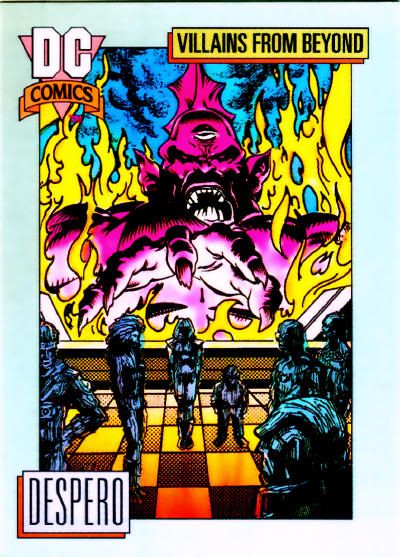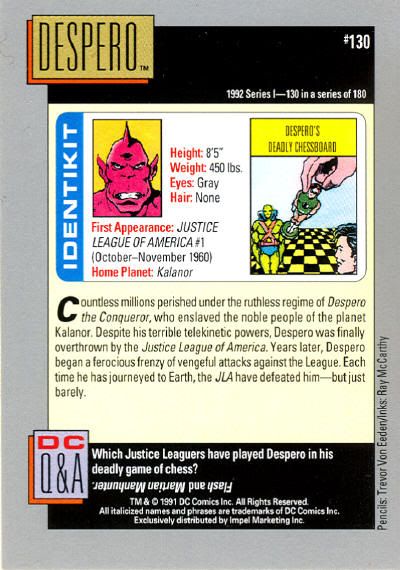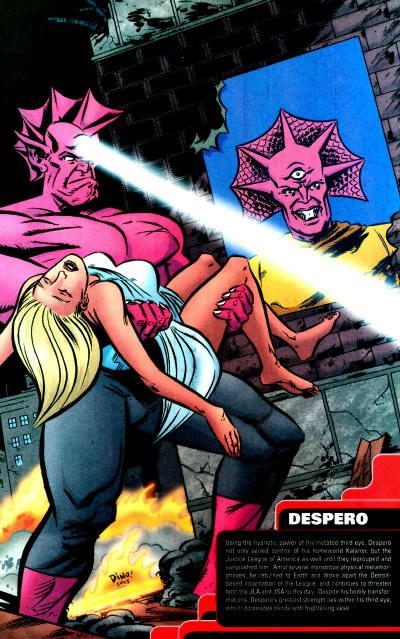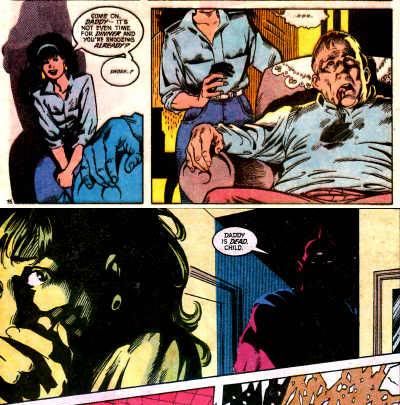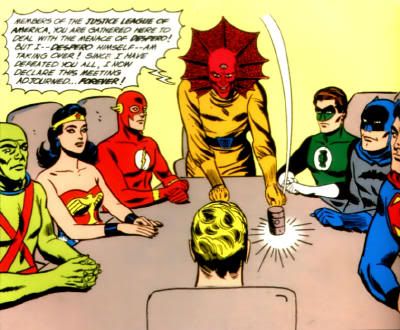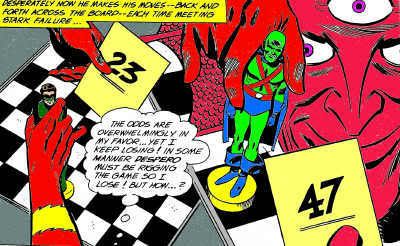Starting in January, the
Idol-Head asked its readers to vote on the Martian Manhunter villains they felt were the most interesting. For most the the year following, we've been counting down from least to most popular, and as we near the top ten, I find that I have gaps with regard to in-depth coverage of some of these characters. Further, I find there's a major difference between bad guys we like, and those that have a meaningful impact on the publishing life of the Manhunter from Mars. Hoping to ease problems in both departments, I've compiled a list of the foes I feel have been the most significant, regardless of personal preferences.
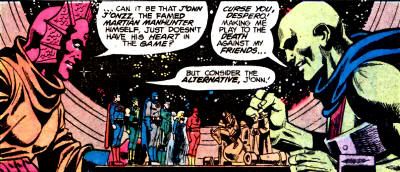 Forensic Psychiatrist Dr. Michael Stone's Scale of Evil Rank
Forensic Psychiatrist Dr. Michael Stone's Scale of Evil Rank
16)
Psychopaths committing multiple vicious acts, which may also include murder.
Why Despero has been selected for 5th Place:
- Despero and the Martian Manhunter are complementary opposites.
J’Onn J’Onzz was a science leader on his world, struggling for resources against an aggressively fascistic regime of another race. Despero was a mutant tyrant who oppressed the political dissent of another race on his dimensional world. J’Onzz was unintentionally teleported to Earth during political exile on Mars. Despero intentionally travelled across dimensions to reach Earth and capture escaping political enemies. J’Onzz chose to assimilate and covertly act as a benevolent agent on a world not his own. Despero’s first order of business was to mentally dominate Earth’s protectors in pursuit of his enemies, then make sport of his intention to wipe out those defenders and immediately return home. Once the presence of a Martian Manhunter on Earth was revealed, J’Onzz operated publicly as part of a heroic team while continuing to privately pursue altruistic ends in human guise. Once Despero was dethroned, he was forced into rehabilitative service under his foes, and secretly plotted against them while pretending to go along with his new role. Both John Jones and Despero faked their own demise to escape their responsibilities and pursue different goals.
Even after the Manhunter was allowed to return home to Mars, he consistently chose to remain on his adoptive Earth, acting in its defense against his own people. While a wanted fugitive, Despero was always plotting his return to Kalanor, only venturing to Earth when attempting to destroy its hated Justice League. Both characters become leaders on their respective worlds whenever they’re actually present. Both character's peoples were made refugees by catastrophe on their planets. Neither character set foot on their home planets throughout the Bronze Age, nor did they have much to do with the planet Earth. Each instead took over new worlds which were never mentioned after the Bronze Age ended. Both attacked Leaguers in the ‘70s due to the manipulation of others, for less than clear reasons.Both got into fights with Supergirl while not in full command of their facilities during a publishing dry spell.
Both Despero and Martian Manhunter have taken on others' identities. The Alien Atlas has lived as John Jones, Marco Xavier and more, while temporarily assuming far too many other forms to list here. The despot has pretended to be Superman and Lex Luthor, plus his spirit once possessed J’Onn J’Onzz. Both characters underwent massive physical, mental and spiritually altering changes in the 1980s. Both were possessed by the minds of other characters for over a year in the 1990s while continuing to make monthly appearances. Both have complex relationships with Gypsy, and served with her on the Justice League Task Force. They remain telepathic, telekinetic, super-strong and nigh-invulnerable aliens with energy projecting vision powers and close ties to the Justice League who occasionally get into brawls with Superman.
- Despero and the Martian Manhunter have complementary publishing histories.
J’Onn J’Onzz and Despero are both Silver Age characters introduced to most readers through their appearances in early issues of
Justice League of America. Both characters were being phased out of the book in the mid-30s. Neither character had very many appearances during the Bronze Age, and most of those were in
JLofA issues written by Gerry Conway (both in a two-parter from 1980.) Conway reintroduced each character within two years of one other in the same series, although neither would see real mainstream acceptance until they were reworked by Keith Giffen and J.M. DeMatteis in
Justice League International. Despero figured into that creative team’s final story arc, and then both characters exited the book. The characters co-starred in
Justice League Task Force for two years, and have together figured into appearances in
Young Justice, Superman/Batman, JLA and more. Neither character has had more appearances with persons of an opposing alignment.
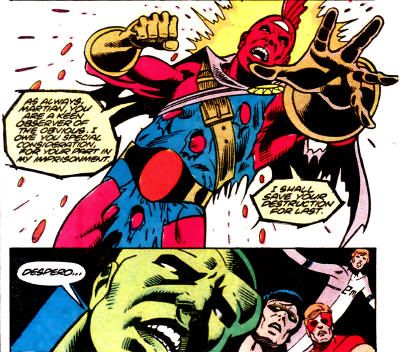
- Despero was the Justice League’s first humanoid extra-terrestrial foe.
The Justice League of America was founded by two super-humans, two normal humans with extraordinary devices, a supernaturally enhanced Amazon, and two aliens. Starro was the first alien being to be confronted by the team, but the group is almost always proactive against the presence of that inhuman creature. Despero is a sentient humanoid who attacked the team for strategic and then personal reasons. Although he tends to target the entire team, he is usually associated with the other aliens present, Superman and especially the Martian Manhunter. It’s alien-on-alien violence. Also, Martian Manhunter from the late ‘80s until the mid ‘00s was considered by many the heart and soul of the Justice League, so when Despero attacked the team, he almost invariably attacked the Martian Manhunter, even when J’onzz wasn’t actually a member of the team.
- Martian Manhunter is the first Justice League member Despero usually targets.
The pecking order of whom Despero ambushed in his first appearance has never been revealed, while his second story started with infecting Snapper Carr, ridiculous architect of his initial defeat. A two-parter in the ‘70s saw aliens enlist Superman’s aid against Despero, which later brought the entire Justice League to bear.
In a story from 1980, Despero kidnapped Martian Manhunter and forced him to act against the Justice League. In 1986, Despero was reborn, and focused his wrath on League founders Batman and Martian Manhunter. In 1990, Despero was reborn again, and worked his way through retired Detroit Leaguers before reaching Martian Manhunter, his primary opponent. When Despero was exercised from his own body, he chose to possess J’Onn J’Onzz. After restoring the memories of the Secret Society of Super-villains, he set that team against the JLA, but saved Martian Manhunter for himself. Despero hates the Justice League, but Martian Manhunter foremost amongst them.
- Despero is among the very few villains to threaten Martian life.
For a character called the Martian Manhunter, J’Onn J’Onzz never spent much time dealing with threats to Mars. Earth has always been the Alien Atlas’ priority, often in opposition to his own people. However, when Mars was rendered uninhabitable, Martian Manhunter resumed his role as a science leader amongst the displaced survivors. In all of those years, only one villain has ever been recorded to have threatened the lives of the entire Martian people under J’Onn J’Onzz’s care. Despero targeted the people of New Mars with a death ray to extort the participation of the Martian Manhunter in a deadly chess game against his former teammates in the Justice League. In fact, the Martian Manhunter threatened to kill Despero for his transgression, a decidedly uncharacteristic show of murderous fury on the hero’s part.
- Despero is Martian Manhunter’s longest lasting rogue.
Longevity is not a hallmark of the Vile Menagerie. The Martian Manhunter had no repeat villains in the ‘50s, and only a handful that showed up more than twice within the 1960s. By his thirtieth anniversary, only one such villain remained: Despero. Fortieth? Despero. Fiftieth? Despero. Everyone else has died or drifted out of J’Onzz’s realm. The Human Flame was recently revived after sitting in limbo since 1959, but his appearances have largely been separate from Martian Manhunter's. Malefic remains dead. None of the other Ostrander/Mandrake foes have reappeared since their series’ demise. Vandal Savage hasn’t directly addressed Martian Manhunter in years. Despero has rumbled with Martian Manhunter every few years since 1980. There’s no competition.
- Martian Manhunter is Despero’s longest lasting adversary.
Jasonar and
Saranna were established as such thorns in Despero’s side, he followed them across dimensions to Earth and battled the JLofA to get to them. However, neither has been mentioned since Despero’s second appearance, and then only in flashback. The Flash was the first hero to engage in one of Despero’s deadly games, but Barry Allen has failed to follow up on any solo claim to the despot for fifty years. Supergirl and Superman have had a few scuffles with Despero, but nothing particularly substantial. Batman, Elongated Man, Gypsy and other former Detroit era Leaguers have had their run-ins, but neither their careers nor their personal animosity against Despero have been sustained. Ditto Glenn Gammeron, Guy Gardner, and other ‘80s/’90s aggressors.
Martian Manhunter fought Despero in his every ’60 & ‘80s appearance, and half of the ‘70s. They were constant foes or teammates throughout the ‘90s, and they’ve had regular encounters since. There is absolutely no other hero that can make a remotely similar assertion.

- Despero savors the Martian Manhunter.
Despero enjoys toying with his foes. A chess match with the Flash, taunting a bound Batman-- but none does he appreciate tormenting as much as J'Onn J'Onzz. Whether through games of chance with his friends and fellow Martians at risk, or through psychic invasions that force him to relive the plague of Mars, J'Onzz always experiences emotional trauma for Despero's pleasure.
- Despero thrives on fire, the Martian Manhunter’s weakness.
The Flame of Py'tar saw Despero reborn in his current form, and an inferno of destruction always follows in his wake. Given his druthers, Earth would end in fire, and the Martian Manhunter would be the green marshmallow roasting on the tip of his clawed finger.
- Despite his victories in single combat, Despero still feels humiliated by the Martian Manhunter, who often sees to his incarceration.
Since his rebirth, Despero has been an overwhelming force of destruction. That power level keeps his abilities above those of the Martian Manhunter and most other solo heroes, so that he remains a force to be reckoned with twenty years after earning the respect of mainstream audiences. However, Despero continues to be defeated, and as the hero most consistently present during Despero's failures, Martian Manhunter remains squarely on Despero's radar. Both character's esteem is fed by their mutual conflict, with each scoring enough points against one another to keep things interesting. Manhunter fans want him to score a decisive victory someday, but at the same time, they are entertained by the menace Despero continues to exude because of his impressive track record. So long as that tension can be sustained, people will keep reading.
- Both Martian Manhunter and Despero have surprising religious ties.
In his first appearance, Despero said of his abilities "my mystic mental powers overwhelmed all..,” and of his hypocritical pseudo-sanctity of life, “Though my Kalanor nature will not permit me to slay you…” A quarter century into his career, Despero became involved with a mystic order that helped him enter and survive the transformative Flame of Py’tar, from which he gained a new physical appearance and enhanced powers.
Meanwhile, J’onn J’onzz was devoted to science/deductive reason in his first few decades, until the fall of Mars caused him to question his lack of faith. Thirty-three years into his career, J'Onn became aware that amnesia and false memories had caused him to lapse in his devotional faith to H’ronmeer. This revelation led to J’Onzz taking on a new “Natural Martian” form, embracing his religious identity, and dismissing his old vulnerability to fire as purely psychosomatic.
- Both characters suffer unjust persecution.
J'onn J'onzz suffered through a kangaroo court that sentenced him to thirteen years of political exile, only to be transported to the United States during one of its many xenophobic frenzies. Most Martian Manhunter solo stories revolve around discrimination of minorities and fear of "the other," including the genocidal racial strife between the Pale/White and Green Martians. Even his fellow members of the Justice League have turned on the Manhunter from Mars at times.
Despero was born a mutant, feared and hated by all on his birth world of Kalanor. It has been hinted that this early prejudice shaped Despero into the sociopath he would become. When captured by his more humanoid enemy Jasonar, Despero's psychic third eye was surgically removed, a rather barbaric means of suppressing his powers. L-Ron also suffered prosecution for Despero's crimes while trapped in his body.
- Despero is the most popular Martian Manhunter adversary.
Darkseid may be better regarded, but no one asks where the Martian Manhunter is whenever the Lord of Apokolips appears. Despero routinely ranks on "top comic book villains" lists, and makes regular appearances across the DC Universe. With such high visibility, it only helps that Despero is closely associated with the Martian Manhunter. Fans of one character always clamor for a rematch with the other, so that each actively buoys the career of the other. In this sense, Despero's hatred is a virtue with regard to the maintenance of J'Onn J'Onzz in comics.
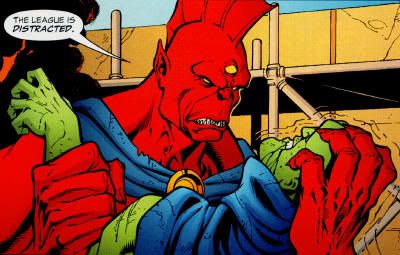 The Counter Argument:
The Counter Argument:
- Despero is a Justice League/DC Universe villain.
- Despero wasn't created to fight Martian Manhunter, so he shouldn't outrank original villains.
- Since the Martian Manhunter can't really beat Despero on his own, the association only hurts the Alien Atlas.
- What's up with that stupid fin?
What Despero Represents:
Despero is simply the evil version of Martian Manhunter. The characters are vastly similar in origins, powers, associates and circumstances, but polar opposites in personality and motivation. Despero is also the embodiment of Martian Manhunter's weaknesses. Basically, J'Onn J'Onzz cannot defeat Despero without help, either literal aides or through a deus ex machina. However, having defeated Despero, Martian Manhunter can't bring himself to execute the fiend, so that the guilt of Despero's inevitable return and the horrors he visits are laid at J'Onzz's feet. Not only does this expose the limitations of the Martian Manhunter's many powers, but also the liability of J'Onzz's morality-- his unwillingness to compromise his principles for the greater good. Worse than J'Onzz's inflexibility is his unwillingness to take responsibility for Despero, as he routinely pawns the rogue off on whomever is convenient for imprisonment. Despero, by virtue of his continued existence, calls into question the very heroism of the Manhunter from Mars, deconstructing him to the core.
Analogies:
- Despero is to the Martian Manhunter as Sabretooth is to Wolverine
as the Kingpin is to Daredevil
as Yellow Claw is to Nick Fury
as Venom is to Spider-Man
as Dormammu is to Dr. Strange
as the Hulk is to the Thing
as Lady Shiva is to Black Canary
Take a respectable B/C-list villain who puts up a fight against A/B-list heroes. Turn said villain into the rival of a similar hero at the same or a lower order than the villain. The adjustment in weight class makes all the difference. The villain's stature rises to such a degree that they can actually be superior to the hero, a prized role in the annals of evil. So long as the hero isn't in the alpha male wish fulfillment category, the hero actually benefits from their vulnerability and need to strategize against the overwhelming threat.
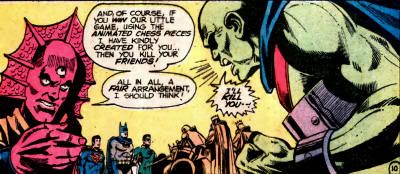 Who isn't ranked because of Despero:
Who isn't ranked because of Despero:
- Doomsday: Always going to be a Superman villain, and he lacks that personal touch.
- Mongul: The Merciless Mongul was to Superman as Despero is to Manhunter, until they ruined him Post-Crisis. Today, he's more likely to fight the Green Lantern Corps, but without a Yellow Power Ring, he's now beneath the Alien Atlas.
- Asmodel: Two battles within a short span of time do not an archfiend make, but he did kill the Martian Manhunter once, so that's something.
- Brimstone: Owned Manhunter in Legends, but got owned during Underworld Unleashed.
- Cabal: Sure they gave J'Onn a hard time in one story, but at the end of the day, it's just a bunch of Jemm villains.
- Korge: Although he was a Mars II problem, it was a Justice League solution, with Martian Manhunter the errand boy calling them in.
- Rott: A Martian Manhunter problem, but a Bloodwynd solution. I feel dirty just typing that.
In Closing:
Despero is a well liked and regarded super-villain with a strong presence in the DC Universe. Although sometimes the butt of jokes because of his ever shifting and often unflattering appearances and dress, Despero perhaps falls a bit shy of the upper echelons, but never so low as to mute his fan base. Despero serves as an intimidating and intriguing foil for the Martian Manhunter, which leads to a mutually beneficial relationship. If only Despero had more impact on J'Onn J'Onzz's continuity, he could be a contender for the top spot.
